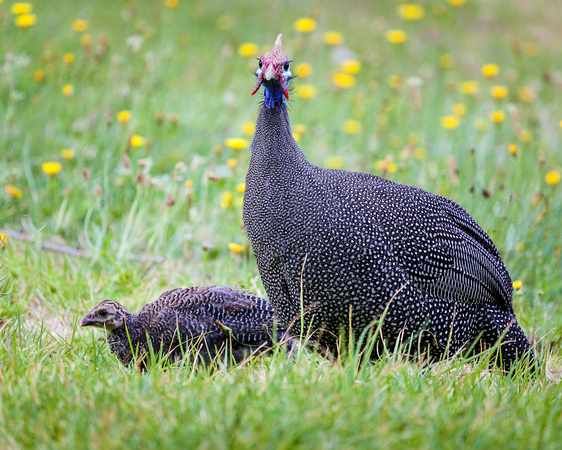Helmeted guineafowl - mother and chick
Helmeted guineafowl (Numida meleagris)
22 inches long
Native to Africa, mainly south of the Sahara, but has been widely introduced into the West Indies, Brazil, Australia and southern France.
The helmeted guineafowl breeds in warm, fairly dry and open habitats with scattered shrubs and trees such as savanna or farmland.
Flocks of guineafowl have flourished in recent years in the Southern Suburbs of Cape Town, where they seem to have adapted remarkably well. The flocks move slowly along the quieter suburban roads, looking for food on the grassy 'pavements' and in gardens where the fence is low enough for some to enter without feeling separated from the flock. They often roost at night on the roofs of bungalows. While residents generally appreciate the local wildlife, it can be a nuisance, obstructing traffic and making a lot of noise in the early morning. Their success is probably due to the large but cautious flock - they can fend off cats, do not enter gardens with dogs, and are visible enough in the quiet roads in which they live to avoid being run over.
Guineafowl are particularly well-suited to consuming massive quantities of ticks, which might otherwise spread lyme disease. Their diet consists of a variety of animal and plant food; seeds, fruits, greens, snails, spiders, worms and insects, frogs, lizards, small snakes and small mammals. Guineafowl are equipped with strong claws and scratch in loose soil for food much like domestic chickens, although they seldom uproot growing plants in so doing.
These birds are terrestrial, and prone to run rather than fly when alarmed. Like most gallinaceous birds, they have a short-lived explosive flight and rely on gliding to cover extended distances. Helmeted guineafowl are great runners, and can walk 6 miles and more in a day. They make loud harsh calls when disturbed.
Photographed at Boulders Beach, Cape Peninsula, South Africa.


